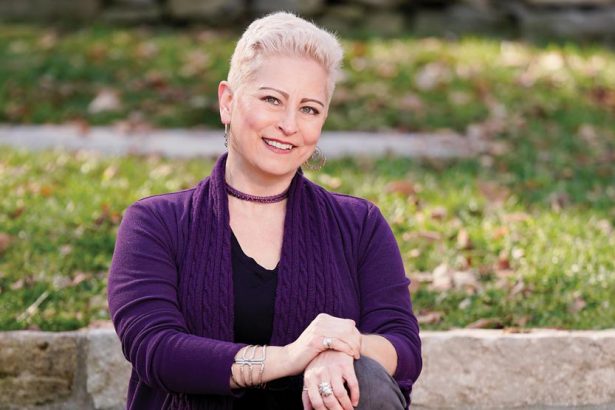Patient Search
 |
 |
|
KaCrole Higgins was diagnosed with breast cancer in 2020. “In May 2020, I found a lump in my breast. I cried. By June, it was diagnosed as breast cancer, triple positive, stage 1A. While getting this cancer diagnosis was devastating, it also became an opportunity. Suddenly, the cancer gave me clarity. It gave me clarity about what was important, what was good in my life, what was toxic in my life, and what I needed to do.” Click below to read more of KaCrole’s story |
If Landon Ryan had been diagnosed with bilateral retinoblastoma 10, 20 or 30 years ago, she might not be here today with nearly perfect vision.Thanks to recent improvements in the treatment for this rare form of cancer that almost exclusively affects children under the age of 5, the diagnosis had the power to change Landon’s life when she was 11 months old, but not to take it — or her eyesight. Click below to learn more about Landon and her story. https://momentum.vicc.org/2022/04/brighter-outlook/ |
Hormonal Therapy after Pertuzumab and Trastuzumab for the Treatment of Hormone Receptor Positive, HER2 Positive Breast Cancer, the ADEPT study
Breast
Breast
This phase II trial studies the effect of hormonal therapy given after (adjuvant) combination pertuzumab/trastuzumab in treating patients with hormone receptor positive, HER2 positive breast cancer. The drugs trastuzumab and pertuzumab are both monoclonal antibodies, which are disease-fighting proteins made by cloned immune cells. Estrogen can cause the growth of breast cancer cells. Hormonal therapy, such as letrozole, anastrozole, exemestane, and tamoxifen, block the use of estrogen by the tumor cells. Giving hormonal therapy after pertuzumab and trastuzumab may kill any remaining tumor cells in patients with breast cancer.
Breast
II
Abramson, Vandana
NCT04569747
VICCBRE2243
Capecitabine Compared to Endocrine Therapy for the Treatment of Non-luminal A Hormone Receptor-Positive Metastatic Breast Cancer
Breast
Breast
This phase II trial compares the effect of capecitabine to endocrine therapy in patients with non-Luminal A hormone receptor-positive breast cancer that has spread from where it first started (primary site) to other places in the body (metastatic). In this study, patients submit a sample of tumor for testing to determine if their breast cancer is considered non-Luminal A. Only patients with non-Luminal A receive study treatment. In the future, doctors hope that this test can assist in picking the best treatment for patients with this type of cancer. Capecitabine is in a class of medications called antimetabolites. It is taken up by tumor cells and breaks down into fluorouracil, a substance that kills tumor cells. Endocrine therapy is treatment that adds, blocks, or removes hormones. To slow or stop the growth of certain cancers (such as prostate and breast cancer), synthetic hormones or other drugs may be given to block the body's natural hormones. Giving capecitabine as compared to endocrine therapy may kill more tumor cells in patients with metastatic breast cancer.
Breast
II
Reid, Sonya
NCT05693766
VICCBRE2256
Niraparib and Dostarlimab as Neoadjuvant Treatment for Patients with BRCA-Mutated or PALB2-Mutated Stage I-III Breast Cancer
Breast
Breast
This phase II trial studies the effects of niraparib in combination with dostarlimab prior to surgery in treating BRCA-mutated or PALB2-mutated stage I-III breast cancer. Niraparib is a PARP inhibitor, which means that it blocks an enzyme (proteins that help chemical reactions in the body occur) in cells called PARP. PARP helps repair deoxyribonucleic acid (DNA) when it becomes damaged. Blocking PARP may help keep cancer cells from repairing their damaged DNA, causing them to die. PARP inhibitors are a type of targeted therapy. Dostarlimab stimulates the immune system by blocking the PD-1 pathway. The PD-1 pathway controls the bodys natural immune response, but for some types of cancer, the immune system does not work as it should and is prevented from attacking tumors. Dostarlimab works by blocking the PD-1 pathway, which may help your immune system identify and catch tumor cells. Giving niraparib in combination with dostarlimab may work better against the tumor and maximize tumor shrinkage before surgery.
Breast
II
Abramson, Vandana
NCT04584255
VICCBRE2190
Avelumab with Binimetinib, Sacituzumab Govitecan, or Liposomal Doxorubicin in Treating Patients with Stage IV or Unresectable, Recurrent Triple Negative Breast Cancer
Breast
Breast
This phase II trial studies how well the combination of avelumab with liposomal doxorubicin with or without binimetinib, or the combination of avelumab with sacituzumab govitecan works in treating patients with triple negative breast cancer that is stage IV or is not able to be removed by surgery (unresectable) and has come back (recurrent). Immunotherapy with checkpoint inhibitors like avelumab require activation of the patient's immune system. This trial includes a two week induction or lead-in of medications that can stimulate the immune system. It is our hope that this induction will improve the response to immunotherapy with avelumab. One treatment, sacituzumab govitecan, is a monoclonal antibody called sacituzumab linked to a chemotherapy drug called SN-38. Sacituzumab govitecan is a form of targeted therapy because it attaches to specific molecules (receptors) on the surface of tumor cells, known as TROP2 receptors, and delivers SN-38 to kill them. Another treatment, liposomal doxorubicin, is a form of the anticancer drug doxorubicin that is contained in very tiny, fat-like particles. It may have fewer side effects and work better than doxorubicin, and may enhance factors associated with immune response. The third medication is called binimetinib, which may stop the growth of tumor cells by blocking some of the enzymes needed for cell growth, and may help activate the immune system. It is not yet known whether giving avelumab in combination with liposomal doxorubicin with or without binimetinib, or the combination of avelumab with sacituzumab govitecan will work better in treating patients with triple negative breast cancer.
Breast
II
Abramson, Vandana
NCT03971409
VICCBRE1987
Ruxolitinib in Preventing Breast Cancer in Patients with High Risk and Precancerous Breast Lesions
Breast
Breast
This phase II trial studies how well ruxolitinib before surgery works in preventing breast cancer in patients with high risk and precancerous breast conditions. Ruxolitinib may changes the breast cell when administered to participants with precancerous breast conditions. Ruxolitinib may stop the growth of cells by blocking some of the enzymes needed for cell growth.
Breast
II
Meszoely, Ingrid
NCT02928978
VICCBRE1904
Talazoparib for the Treatment of BRCA 1/2 Mutant Metastatic Breast Cancer
Breast
Breast
This phase II trial studies how well talazoparib works for the treatment of breast cancer with a BRCA 1 or BRCA 2 gene mutation that has spread to other places in the body (metastatic). Talazoparib is a study drug that inhibits (stops) the normal activity of certain proteins called poly (ADP-ribose) polymerases also called PARPs. PARPs are proteins that help repair deoxyribonucleic acid (DNA) mutations. PARP inhibitors, such as talazoparib, can keep PARP from working, so tumor cells can't repair themselves, and they may stop growing. PARPs are needed to repair mistakes that can happen in DNA when cells divide. If the mistakes are not repaired, the defective cell will usually die and be replaced. Cells with mistakes in their DNA that do not die can become tumor cells. Tumor cells may be killed by a study drug, like talazoparib, that stops the normal activity of PARPs. Talazoparib may be effective in the treatment of metastatic breast cancer with BRCA1 or BRCA2 mutations.
Breast
II
Abramson, Vandana
NCT03990896
VICCBRE2265
Avelumab or Hydroxychloroquine with or without Palbociclib for the Treatment of Stage II-III Breast Cancer, PALAVY Study
Breast
Breast
This phase II trial investigates the effect of avelumab or hydroxychloroquine sulfate with or without palbociclib in treating patients with stage II-III breast cancer that is positive for disseminated tumor cells (DTCs) after curative therapy. DTCs are breast cancer cells that are asleep (dormant) in the bone marrow. There are multiple ways in which these cells stay alive, and three of these mechanisms are inhibited by the drugs in this trial. First, dormant cancer cells need a protein signal pathway involving CDK 4/6 to start dividing once they wake up in order to survive as an active cancer cell. Palbociclib works by blocking the CDK 4/6 protein and by doing so may limit the dormant cancer cell from being able to survive. In addition, palbociclib may also help both of the other drugs in the trial to work better. Second, dormant cancer cells also use a process called autophagy to generate their own nutrition, which can allow them to stay asleep. Hydroxychloroquine has been shown to block autophagy, which leads to starvation of the cells. Third, dormant cancer cells are able to hide from the bodys immune system. The immune system sends a type of cell called T cells throughout the body to detect and fight infections and diseasesincluding cancers. One way the immune system controls the activity of T cells is through the PD-1/PD-L1 (programmed cell death protein-1) pathway. However, some cancer cells hide from T-cell attack by taking control of the PD-1/PD-L1 interaction and this stops T cells from attacking cancer cells. Avelumab is an antibody designed to block the PD-1/PD-L1 pathway and helps the immune system in detecting and fighting dormant cancer cells. Because palbociclib, hydroxychloroquine, and avelumab work on the mechanisms that keep the dormant cells alive, taking one or a combination of these drugs may be able to eliminate DTCs.
Breast
II
Reid, Sonya
NCT04841148
VICCBRE2161



